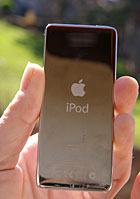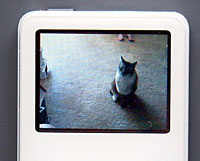|
|
|||||||
|
Apple iPod Reviews Apple iPod nanoEditor's rating (1-5): Check out our review of the 3rd generation nano, released September 2007. Reviewed Jan, 27, 2006 by Jacob Spindel, Chief iPod Correspondent Nano has always been the metric prefix for "10^-9." However, it also recently became an Apple suffix for "really cool iPod." The iPod nano is Apple's replacement for the now-discontinued iPod mini, which was enormously popular. The nano certainly doesn't disappoint in the "coolness" factor; this is another case of "to see one is to want one." But in terms of features and functionality, does it actually live up to the hype well enough to prevent people from demanding the return of the mini? In a word: yes! Nano 411 At a mere 3.5 x 1.6 x 0.27 inches and 1.5 ounces, the nano is 0.1 inch narrower, 0.4 inches shorter, and 0.23 inches shallower than the mini. It also weighs 2.1 ounces less than the mini — a 58% reduction.
The nano features an even smaller version of the click-wheel that has become synonymous with the iPod (even though it wasn't present in the 1Gs, 2Gs, or 3Gs). In spite of its size, I found the new wheel to be responsive and accurate. It also has a standard iPod Dock Connector and a standard 3.5" headphone minijack, both of which are now on the bottom of the device. In fact, the standard hold switch is the only item that is still located at the top of the nano, which is otherwise just an "empty" metallic surface. It is unclear why Apple moved the headphone jack, but it doesn't have any negative effects on the device's usability, except that it can be a little tricky to unplug the charging cable if your headphones' plug gets in the way. Apple's standard earbuds are also included. But probably the most exciting piece of the nano is its screen. At 1.5" diagonally, it is physically slightly smaller than the mini's screen, but its resolution of 176 x 132 pixels, combined with the new 16-bit color capability, make a dramatic difference. For most mini owners, the new screen is the best reason to upgrade.
Of course, all the iPod "standards" are here too, like audiobook capability with speed control, the calendar, the address book, notes, and games. The games are the same four that have appeared on many previous models, but Solitaire is definitely better in color. As usual, the nano supports the MP3, AAC, protected AAC, Apple Lossless, and AIFF codecs for playing back audio files. The nano also adds a stopwatch feature as well as a "Screen Lock" that allows you to use the click-wheel like a padlock to prevent others from gaining unauthorized access your iPod. Although these additions are minor, they are good ideas that can certainly come in handy. |
Advertisement |
|||||||||
|
Wait! What about the remote port? It's gone, just like on the iPod 5G. In terms of actual remote controls, the nano and 5G are actually the only devices that support Apple's new FM Radio Remote (firmware update may be required), so I doubt many people will miss the original iPod remote control. However, this also means that any other devices that use the remote port for any reason, such as some iTrip models and other FM transmitters, cannot be used with the nano. The only other notable feature to be removed is FireWire syncing. That's right—you can only sync over USB, even though it has a standard Dock Connector. The good news is that, if you have a myriad of iPod cables on your desk and accidentally connect a FireWire cable to your nano, the nano displays a clear and helpful error message, which is highly preferable to crashing (or melting!), and more elegant than the dreaded "just sits there and does nothing." The iPod nano is available in a 2 GB model that holds about 500 songs, with an expected retail price of $199, and a 4 GB model that holds about 1,000 songs, with an expected retail price of $249. Both models are available in black and white, but not any other colors. Thus, the nano is admittedly not as "colorful" as the mini and has an even higher cost-per-gigabyte. So why is it better than the mini? Read on. Nano Fanno Bo Banno
You can also hit the center button while a track is playing to cycle through standard mode, rating mode, and seeking mode, as with previous models—but now there are also two more modes, where you can view a larger image of the album art, or see the lyrics. (Of course, you must have these items entered into iTunes before you sync.) These are welcome additions that finally leverage some of the new features in iTunes, which had seemed a bit pointless without iPod support. News Flash Perhaps the second-most radical change after the screen is the use of flash memory instead of a MicroDrive. This is indeed the reason that the cost per gigabyte has increased, and the reason that there is currently no 6 GB model. However, I feel that the advantages of flash memory easily outweigh the drawbacks: It allows for the nano's smaller size and faster response time. It is also less likely to break due to fewer moving parts. The biggest advantage of all: battery life. I actually like to select tracks manually, one at a time, while listening to an iPod. This type of random access caused havoc to my old iPod mini's battery, which had reached a point where it could only provide about 30 minutes of charge by the time I had owned it for 367 days (i.e., 2 days past the warranty period). Thankfully, flash memory has no such problem. I can't even give a realistic estimate how long the nano's battery charge will last, because it seems like no matter how long I use it, the battery meter is still on "full." Suffice it to say that the battery will last a LONG time, and hopefully this decreased wear and tear will improve the overall lifespan of the battery. Although it is now flash-based, the nano can still be used like an external drive in exactly the same way as its predecessors. |
Advertisement |
|
Nano No-No's This was supposed to be the part of the review where I state the drawbacks and things I didn't like about the nano—but there aren't any. I really only have one complaint about the nano, which is that Apple doesn't seem to have figured out exactly how the nano fits into their new campaign for using video instead of just audio. The nano can't play videos (unless you install Linux, as we reported here), presumably because Apple doesn't think it has enough storage for videos to be a good idea. They're probably right about that, too. But if Apple expects you to pay $1.99 for videos and store them in your music library, iTunes should at least create an audio-only version of the video and sync that to the nano instead. As it stands, for unprotected media you will have to keep two different copies, both audio and video, in your library, and for protected media (from the iTunes Music Store), you may actually have to buy two different versions if you want both the video and nano compatibility, since you can't rip the audio from a protected video. You might be able to come up with a Manual Syncing solution that optimizes this situation somewhat, but all this is just too much of a hassle. Apple really needs to incorporate the iPod nano into their range of video-aware products, even if it means just changing iTunes without adding any features to the nano itself. Just Buy It Already! I have owned three different iPod models, and in my opinion, they just keep getting better. The nano is certainly my favorite iPod so far, and I would highly recommend it to anyone looking for a high-quality music player. What are you waiting for, the iPod pico? (That's 10^-12, by the way.) Pros: Brilliant color screen; Excellent form factor, size, and ergonomics; long battery life; compatible with FM Radio Remote accessory; retains virtually all the positive aspects of previous iPod models. Cons: No video integration. Battery isn't removable.
Price: $199 for 2 gig, $249 for 4 gig Web Site: www.apple.com/ipod Comparison Shopping: Where to Buy
|




